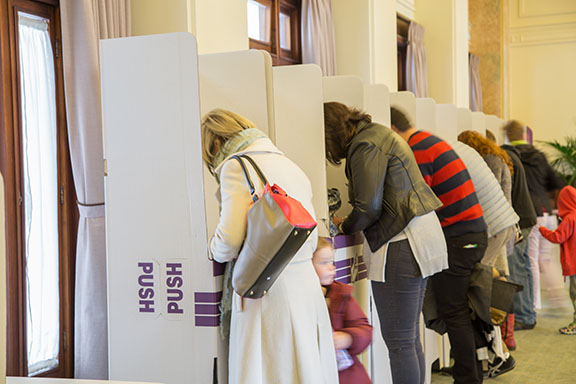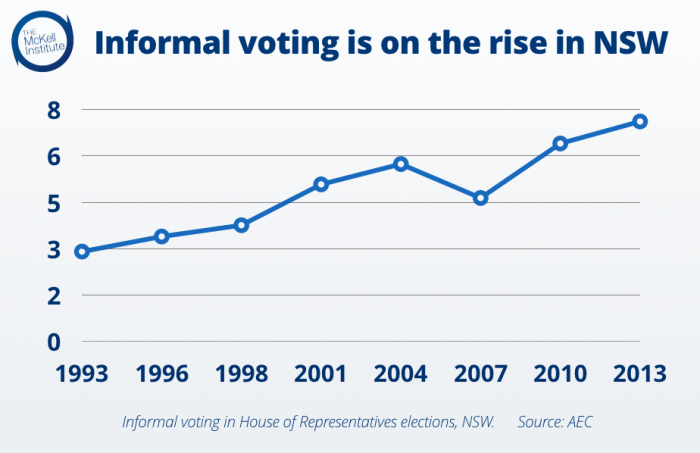All NSW residents on the electoral roll will be required to vote this Saturday, if they have not done so already. When they do, they can vote just [1] for their preferred candidate, or rank all the boxes, or any number of boxes.
This is the current system of optional preferential voting – which allows for voters to mark a preference for as many candidates as they want.
Two months later, they’ll be required to vote in the Australian Federal Election. Except in this election any votes that don’t number all the boxes will be deemed informal and thrown out – under the system of mandatory preferential voting. Every lower house vote must preference all the candidates. In seats such as Warringah and Kooyong that could feature a large number of independents, a failure to preference any single one of them will result in an informal vote.
Inconsistent Systems
It’s hard not to feel sorry for the residents of Australia’s largest state – who run the risk of having their votes thrown out if they were to vote consistently within the space of two months.
Even so, adding in the upper house causes more confusion. For the NSW Election Legislative Council ballot- voters may number at least one box above the line, or at least 15 boxes below the line. Two months later, they must number at least 6 boxes above the line and at least 16 boxes below the line for the Senate preferences.
NSW House of Reps votes have seen an increase in informal voting over recent years. While specific breakdowns are not released, it can be presumed that a plurality of the votes that are discarded are votes that have not marked all the boxes.
Wasted Votes
Optional preferential voting leads to situations where due to informal votes, the presumed will of the electorate is not reflected in the final result. Under this system, votes that do not preference past an eliminated candidate are literally ‘exhausted’ – the electoral equivalent of being thrown in a waste paper basket. No reasonable person can look on this and conclude that a system where large portions of the vote do not impact the final result – is the will of the electorate.
As votes get excluded and preferences do not flow, the candidate in a tight seat who is elected is not the candidate who won the will of the third parties, but the one that won the will of the third party voters who preference.
Consider the electorate of Coogee at the 2015 state election. There, the Liberal candidate finished on 21, 564 first preference votes, the Labor candidate on 15,073 first preference votes and the Greens on 8,609.
| Coogee – First Preference Votes (Source: NSWEC) | ||
| Party | Votes | % |
| ALP | 15,073 | 32.54 |
| No Land Tax | 612 | 1.32 |
| CDP | 612 | 1.00 |
| Greens | 8,609 | 18.59 |
| Liberal | 21,564 | 46.55 |
Here the ALP+Greens vote exceeds the LIB vote significantly. We know that when Greens voters preference, as many as 80% of their votes flow to Labor. However, due to the fact that a significant number of them did not preference, the Liberal candidate finished higher, winning the preferences of the smaller parties.
| Coogee – Two party preferred (Source: NSWEC) | ||
| Party | Votes | % |
| ALP | 20,031 | 47.1 |
| Liberal | 22,517 | 52.9 |
What happened in Queensland?
In the above example, mandatory preferential voting benefitted the Labor party, however Queensland demonstrates that this is not universal.
In 2017 – the Labor Palaszczuk government scrapped optional preferential voting in favour of mandatory preferential voting.
Later, it was argued that the government would regret this. The reasoning behind this is the theory that One Nation’s vote drained the Liberal primary vote count down – normally good for Labor. However, under a system of mandatory preferential voting, the Liberal party would stand to benefit as they would receive an increased flow from excluded One Nation candidates.
This theory manifested in the seat of Burdekin – the LNP won the seat with a 2PP of 50.8/49.2 – despite Labor’s candidate beating the LNP candidate by 4.3%. 61% of the One Nation votes carried to the LNP. If at least 50% of these votes had been exhausted, as would have happened under Optional Preferential Voting, Labor would have presumably won the seat.
While this was not an overall issue for the government due to large swings towards it in Brisbane’s suburbs – mandatory preferential voting hurt Labor in the regional seats.
Still, the Palaszczuk government has revealed no intention of reversing their switch to mandatory preferential voting – ideally because they see the benefits of having a consistent voting system that is rationalised with how the state votes federally.
Due to the unpredictable nature of Australian politics, third parties and voting patterns – mandatory preferential voting would see no favour to either of Australia’s main political parties. It would however guarantee that in most cases, the genuine will of the voter is expected to be expressed.
Even if unconvinced by the merits of the mandatory preferential system – the confusion to voters in NSW necessitates either State or Federal change. Mandatory preferential voting is universal across all other territories, bar Northern Territory.
For the sanctity of the voter and the hopeful ultimate expression of their will – it makes sense for this to be the system that all voters should come to expect when they attend the ballot box.





SOCIAL SHARE